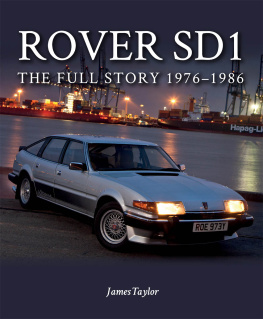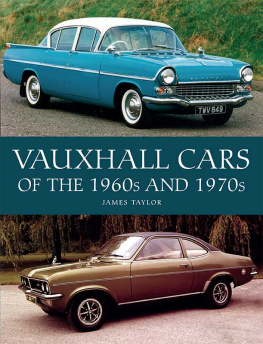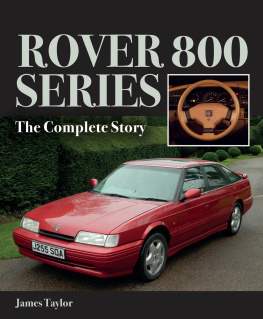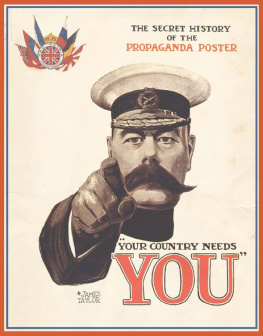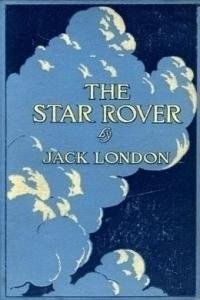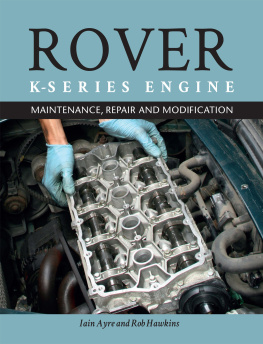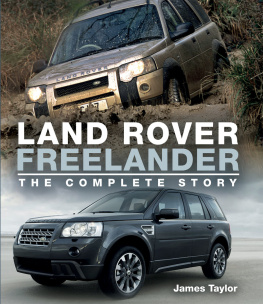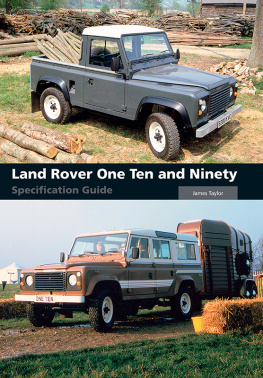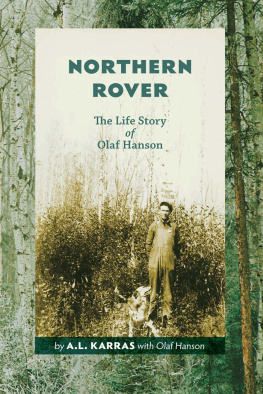OTHER TITLES IN THE CROWOOD AUTOCLASSICS SERIES
ALFA ROMEO 916 GTV AND SPIDER Robert Foskett
ALFA ROMEO SPIDER John Tipler
ASTON MARTIN DB4, DB5 & DB6 Jonathan Wood
ASTON MARTIN DB7 Andrew Noakes
ASTON MARTIN V8 William Presland
AUDI QUATRO Laurence Meredith
AUSTIN HEALEY Graham Robson
BMW CLASSIC COUPS James Taylor
BMW M3 James Taylor
BMW M5 James Taylor
CITRON DS SERIES John Pressnell
FERRARI 308, 328 AND 348 Robert Foskett
FORD CONSUL, ZEPHYR AND ZODIAC Graham Robson
FORD ESC ORT RS Graham Robson
FROGEYE SPRITE John Baggott
JAGUAR E-TYPE Jonathan Wood
JAGUAR MKS 1 AND 2, S-TYPE AND 420 James Taylor
JAGUAR XK8 Graham Robson
JENSEN V8 Mark Dollery
JOWETT JAVELIN AND JUPITER Geoff McAuley & Edmund Nankivell
LAMBORGHINI COUNTACH Peter Dron
LAND ROVER DEFENDER, 90 AND 110 RANGE James Taylor
LOTUS ELAN Matthew Vale
MGA David G. Styles
MGB Brian Laban
MGF AND TF David Knowles
MG T-SERIES Graham Robson
MAZDA MX-5 Antony Ingram
MERCEDES-BENZ CARS OF THE 1990s James Taylor
MERCEDES-BENZ FINTAIL MODELS Brian Long
MERCEDE S-BENZ S-CLASS James Taylor
MERCEDE S-BENZ W124 James Taylor
MERCEDES SL SERIES Andrew Noakes
MERCEDES W113 Myles Kornblatt
MORGAN 4/4 Michael Palmer
MORGAN THREE-WHEELER Peter Miller
PEUGEO T 205 Adam Sloman
PORSCHE 924/928/944/968 Glen Smale
PORSCHE CARRERA THE AIR-COOLED ERA Johnny Tipler
RELIANT THREE-WHEELERS John Wilson-Hall
RILEY RM John Price-Williams
ROVER 75 AND MG ZT James Taylor
ROVER P4 James Taylor
ROVER P5 & P5B James Taylor
SAAB 99 & 900 Lance Cole
SHEL BY & AC COBRA Brian Laban
SUBARUIMPREZA WRX AND WRX STI James Taylor
SUNBEAM ALPINE AND TIGER Graham Robson
TOYOTA MR2 Nigel Burton
TRIUMPH SPITFIRE & GT6 Richard Dredge
TRIUMPH TR7 David Knowles
VOLKSWAGEN GOLF GTI James Richardson
VOLVO AMAZON Richard Dredge
VOLVO P1800 David G. Styles
ROVER SD1
THE FULL STORY 19761986
James Taylor
ROVER SD1
THE FULL STORY 19761986
James Taylor

THE CROWOOD PRESS
First published in 2016 by
The Crowood Press Ltd
Ramsbury, Marlborough
Wiltshire SN8 2HR
www.crowood.com
This e-book first published in 2016
James Taylor 2016
All rights reserved. No part of this publication may be reproduced or transmitted in any form or by any means, electronic or mechanical, including photocopy, recording, or any information storage and retrieval system, without permission in writing from the publishers.
British Library Cataloguing-in-Publication Data
A catalogue record for this book is available from the British Library.
ISBN 978 1 78500 192 5
Disclaimer
Every reasonable effort has been made to trace and credit illustration copyright holders. If you own the copyright to an image appearing in this book and have not been credited, please contact the publisher, who will be pleased to add a credit in any future edition.
CONTENTS

INTRODUCTION AND ACKNOWLEDGEMENTS
The Rover SD1 was the new kid on the block when I first became interested in the products of the Rover Company. By that time, of course, there was no Rover Company any more, and Rover was just a name used for the car that fitted into a certain bracket within the British Leyland range hierarchy. However, the SD1 had been largely designed by the old Rover team, and was built at the old Rover factory in Solihull. So it felt like a real Rover, and I joined many others in hoping that it would become a success.
As we now know, the multiple problems that beset British Leyland in the 1970s meant that the SD1 never really fulfilled its true potential. Quality was so variable that buying one in the first five or so years of its life was a calculated risk. I have owned four of them, and one of them (a late model 2600) was a really good car. That says it all, really.
Yet the SD1 was fundamentally an excellent design. I followed its progress throughout its production life, and was lucky enough to meet and interview several people involved with it. So I owe a major debt of gratitude to Gordon Bashford, Spen King and David Bache, all of whom enlightened me about the background to the design. There were many others, too, some of them acknowledged in the narrative.
In putting this book together, I also drew on the knowledge and enthusiasm of several other people. In particular, I must single out Ian Elliott, who had the unenviable task of preparing most of the UK press releases about the car, and who saw much of the story from the inside. On the enthusiast side, thanks go to Chris Powell, historian of the Rover SD1 Club, whose research provided valuable information that was not available elsewhere. I am very grateful also to Paddy Carpenter, of the Police Vehicle Enthusiasts Club, for providing a number of photographs relating to his specialism. Several overseas enthusiasts added their knowledge of SD1 sales outside the UK, so thanks go to Rob Turner and Tony Cope in Australia, John Miller in New Zealand, Rob Hafkamp in the Netherlands and to Joo Peres and Jos Almeida in Portugal. Others have certainly added to my knowledge over the years, and Im sorry I cant remember and list every one of them here.
Most of the photographs and illustrations have come from my own collection. However, I must add special thanks to photographer Craig Pusey for the photographs of his Vitesse and to Lisa Stevens at the British Motor Industry Heritage Trust in Gaydon. Please note that all publicity material and photographs originally produced for or by the British Leyland Motor Corporation and British Leyland Ltd, including all its subsidiary companies, is now the copyright of the British Motor Industry Heritage Trust; anyone wishing to reuse this material should contact BMIHT for permission to do so. Finally, in quoting VINs I have gone for additional clarity by inserting a hyphen between the prefix code and the serial number (eg SARRRWVF3AA-000803). This hyphen does not appear on the identification plates or on documents associated with the cars.
James Taylor
Oxfordshire
October 2015

The oldest-known Rover SD 1. Wearing chassis number five and registration number JYF 227N, the car was built in 1975 as a pre-production model.
CHAPTER ONE

EARLY DEVELOPMENT, 19691972
THE ROVER STORY
Although the Rover name remained constant during the production life of the SD1, the Rover identity was in an almost constant state of change. To document those changes in detail as they occurred would unnecessarily complicate the story of the car, so they are explained here as a way of providing some context for the story that follows.
Rover began making cars in 1904, and before that had been involved in the bicycle and sewing machine industries in Coventry. However, it was not until the 1930s that the company really made its name, under the guidance of brothers Spencer Wilks as managing director and Maurice Wilks as chief engineer. Rover became makers of One of Britains Fine Cars, as their publicity material put it, building discreet and elegant cars of high quality that were largely aimed at the professional middle classes.
Next page
